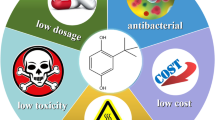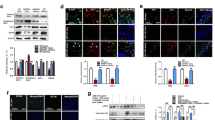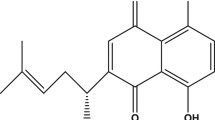Abstract
β-Amyloid (Aβ) peptide, a major component of senile plaques has been regarded to play a crucial role in the development and neuropathogenesis of Alzheimer’s disease (AD). Increasing data from in vitro and in vivo studies indicate that Aβ-induced damages in neurons and glia are mediated via nitrosative as well as oxidative stress. Therefore, recent researches have been focused on searching for dietary and herbal manipulations to protect against the Aβ-induced oxidative and/or nitrosative cell death. Epigallocatechin-3-gallate (EGCG), one of these candidates is a major polyphenolic compound present in green tea and has been reported to exhibit potent antioxidant and anti-inflammatory properties. In the present study, we have investigated the effect of EGCG against Aβ-induced oxidative and/or nitrosative cell death in BV2 microglia. Aβ treatment led to apoptosis in BV2 cells as revealed by DNA fragmentation, perturbation of mitochondrial transmembrane potential, and alterations in the expression of apoptosis-regulator Bcl-2 family proteins. EGCG pretreatment effectively ameliorated Aβ-induced cytotoxicity and manifestation of proapoptotic signals. Furthermore, BV2 cells exposed to Aβ underwent nitrosative stress as shown by the increased expression of inducible nitric oxide synthase (iNOS) and subsequent production of nitric oxide (NO) and peroxynitrite, which were effectively suppressed by EGCG pretreatment. To elucidate a molecular mechanism underlying the neuroprotective effect of EGCG, we have examined the cellular metabolism of reduced glutathione (GSH) with antioxidant properties. EGCG treatment fortified cellular GSH pool through elevated mRNA expression of γ-glutamylcysteine ligase (GCL), the rate limiting enzyme in the glutathione biosynthesis. These results suggest that EGCG may have preventive and/or therapeutic potential in AD patients by augmenting cellular antioxidant defense capacity and attenuating Aβ-mediated oxidative and/or nitrosative cell death.
Similar content being viewed by others
References
Akama, K. T., Albanese, C., Pestell, R. G., and Van Eldik, L. J., Amyloid β-peptide stimulates nitric oxide production in astrocytes through an NF-κB-dependent mechanism. Proc. Natl. Acad. Sci. U.S.A., 95, 5795–5800 (1998).
Alkam, T., Nitta, A., Mizoguchi, H., Itoh, A., and Nabeshima, T., A natural scavenger of peroxynitrites, rosmarinic acid, protects against impairment of memory induced by Aβ25–35. Behav. Brain Res., 180, 139–145 (2007).
Ban, J. Y., Jeon, S. Y., Bae, K., Song, K. S., and Seong, Y. H., Catechin and epicatechin from Smilacis chinae rhizome protect cultured rat cortical neurons against amyloid β protein (25–35)-induced neurotoxicity through inhibition of cytosolic calcium elevation. Life Sci., 79, 2251–2259 (2006).
Behl, C., Alzheimer’s disease and oxidative stress: implications for novel therapeutic approaches. Prog. Neurobiol., 57, 301–323 (1999).
Bolaños, J. P., Almeida, A., Stewart, V., Peuchen, S., Land, J. M., Clark, J. B., and Heales, S. J., Nitric oxide-mediated mitochondrial damage in the brain: mechanisms and implications for neurodegenerative diseases. J. Neurochem., 68, 2227–2240 (1997).
Braak, B. and Braak, E., Neeuropathological staging of Alzheimer-related changes. Acta Neuropathol., 82, 239–259 (1991).
Calabrese, V., Boyd-Kimball, D., Scapagnini, G., and Butterfield, D. A., Nitric oxide and cellular stress response in brain aging and neurodegenerative disorders: the role of vitagenes. In Vivo, 18, 245–267 (2004).
Calabrese, V., Guagliano, E., Sapienza, M., Panebianco, M., Calafato, S., Puleo, E., Pennisi, G., Mancuso, C., Butterfield, D. A., and Stella, A. G., Redox regulation of cellular stress response in aging and neurodegenerative disorders: role of vitagenes. Neurochem. Res., 32, 757–773 (2007).
Chauhan, V. and Chauhan, A., Oxidative stress in Alzheimer’s disease. Pathophysiology, 13, 195–208 (2006).
Choi, Y. T., Jung, C. H., Lee, S. R., Bae, J. H., Baek, W. K., Suh, M. H., Park, J., Park, C. W., and Suh, S. I., The green tea polyphenol (−)-epigallocatechin gallate attenuates β-amyloid-induced neurotoxicity in cultured hippocampal neurons. Life Sci., 70, 603–614 (2001).
Choi, Y. B., Kim, Y. I., Lee, K. S., Kim, B. S., and Kim, D. J., Protective effect of epigallocatechin gallate on brain damage after transient middle cerebral artery occlusion in rats. Brain Res., 1019, 47–54 (2004).
Chung, H. T., Pae, H. O., Choi, B. M., Billiar, T. R., and Kim, Y. M., Nitric oxide as a bioregulator of apoptosis. Biochem. Biophys. Res. Commun., 282, 1075–1079 (2001).
Combs, C. K., Karlo, J. C., Kao, S. C., and Landreth, G. E., β-Amyloid stimulation of microglia and monocytes results in TNFα-dependent expression of inducible nitric oxide synthase and neuronal apoptosis. J. Neurosci., 21, 1179–1188 (2001).
Coppola, S. and Ghibelli, L. GSH extrusion and and the mitochondrial pathway of apoptotic signalling. Biochem. Soc. Trans., 28, 56–61 (2000).
Crouch, P. J., Harding, S. M., White, A. R., Camakaris, J., Bush, A. I., and Masters, C. L. Mechanisms of Aβ mediated neurodegeneration in Alzheimer’s disease. Int. J. Biochem. Cell. Biol., 40, 181–198 (2008).
Dheen, S. T., Jun, Y., Yan, Z., Tay, S. S., and Ling, E. A. Retinoic acid inhibits expression of TNF-α and iNOS in activated rat microglia. Glia, 50, 21–31 (2005).
Franco, R., Schoneveld, O. J., Pappa, A., and Panayiotidis, M. I., The central role of glutathione in the pathophysiology of human diseases. Arch. Physiol. Biochem., 113, 234–258 (2007).
Gebicke-Haerter, P. J., Microglia in neurodegeneration: molecular aspects. Microsc. Res. Tech., 54, 47–58 (2001).
Goodwin, J. L., Uemura, E., and Cunnick, J. E., Microglial release of nitric oxide by the synergistic action of β-amyloid and IFN-γ. Brain Res., 692, 207–214 (1995).
Grundman, M., Grundman, M., and Delaney, P., Antioxidant strategies for Alzheimer’s disease. Proc. Nutr. Soc. 61, 191–202 (2002).
Haque, A. M., Hashimoto, M., Katakura, M., Tanabe, Y., Hara, Y., and Shido, O., Long-term administration of green tea catechins improves spatial cognition learning ability in rats. J. Nutr., 136, 1043–1047 (2006).
Hu, J., Akama, K. T., Krafft, G. A., Chromy, B. A., and Van Eldik, L. J., Amyloid-β peptide activates cultured astrocytes: morphological alterations, cytokine induction and nitric oxide release. Brain Res., 785, 195–206 (1998).
Huang, Q., Wu, L. J., Tashiro, S., Gao, H. Y., Onodera, S., and Ikejima, T., (+)-Catechin, an ingredient of green tea, protects murine microglia from oxidative stress-induced DNA damage and cell cycle arrest. J. Pharmacol. Sci., 98, 16–24 (2005).
Ii, M., Sunamoto, M., Ohnishi, K., and Ichimori, Y., β-Amyloid protein-dependent nitric oxide production from microglial cells and neurotoxicity. Brain Res., 720, 93–100 (1996).
Jang, J. H. and Surh, Y. J., Bcl-2 protects against Aβ25–35-induced oxidative PC12 cell death by potentiation of antioxidant capacity. Biochem. Biophys. Res. Commun., 320, 880–886 (2004).
Jang, J. H., Aruoma, O. I., Jen, L. S., Chung, H. Y., and Surh, Y. J., Ergothioneine rescues PC12 cells from bamyloid-induced apoptotic death. Free Radic. Biol. Med., 36, 288–299 (2004).
Jang, J. H., Kim, C. Y., Lim, S. H., Yang, C. H., Song, K. S., Han, H. S., Lee, H. K., and Lee, J. W., Neuroprotective Effects of Triticum aestivum L. against β-Amyloidinduced Cell Death and Memory Impairments. Phytother. Res., in press.
Jang, M. H., Jung, S. B., Lee, M. H., Kim, C. J., Oh, Y. T., Kang, I., Kim, J., and Kim, E. H., Melatonin attenuates amyloid beta25–35-induced apoptosis in mouse microglial BV2 cells. Neurosci Lett., 380, 26–31 (2005).
Law, A., Gauthier, S., and Quirion, R., Say NO to Alzheimer’s disease: the putative links between nitric oxide and dementia of the Alzheimer’s type. Brain Res. Brain Res. Rev., 35, 73–96 (2001).
Lee, S. Y., Lee, J. W., Lee, H., Yoo, H. S., Yun, Y. P., Oh, K. W., Ha, T. Y., and Hong, J. T., Inhibitory effect of green tea extract on β-amyloid-induced PC12 cell death by inhibition of the activation of NF-κB and ERK/p38 MAP kinase pathway through antioxidant mechanisms. Brain Res. Mol. Brain Res., 140, 45–54 (2005).
Lee, S. J. and Lee, K. W., Protective effect of (−)-epigallocatechin gallate against advanced glycation endproducts-induced injury in neuronal cells. Biol. Pharm. Bull., 1369–1373 (2007).
Li, Y., Liu, L., Barger, S. W., Mrak, R. E., and Griffin, W. S. Vitamin E suppression of microglial activation is neuroprotective. J. Neurosci. Res., 66, 163–170 (2001).
Li, R., Huang, Y. G., Fang, D., and Le, W. D. (−)-Epigallocatechin gallate inhibits lipopolysaccharide-induced microglial activation and protects against inflammation-mediated dopaminergic neuronal injury. J. Neurosci. Res., 78, 723–731 (2004).
Li, M. H., Jang, J. H., Na, H. K., Cha, Y. N., and Surh, Y. J., Carbon monoxide produced by heme oxygenase-1 in response to nitrosative stress induces expression of glutamate-cysteine ligase in PC12 cells via activation of phosphatidylinositol 3-kinase and Nrf2 signaling. J. Biol. Chem., 282, 28577–28586 (2007).
Lin, L. C., Wang, M. N., Tseng, T. Y., Sung, J. S., and Tsai, T. H., Pharmacokinetics of (−)-epigallocatechin-3-gallate in conscious and freely moving rats and its brain regional distribution. J. Agric. Food Chem., 55, 1517–1524 (2007).
Luetjens, C. M., Lankiewicz, S., Bui, N. T., Krohn, A. J., Poppe, M., and Prehn, J. H. Up-regulation of Bcl-xL in response to subtoxic β-amyloid: role in neuronal resistance against apoptotic and oxidative injury. Neuroscience, 102, 139–150 (2001).
Luth, H. J., Holzer, M., Gartner, U., Staufenbiel, M., and Arendt, T., Expression of endothelial and inducible NOS-isoforma is increased in Alzheimer’s disease, in APP23 transgenic mice and after experimental brain lesion in rat: evidence for an induction by amyloid pathology. Brain Res., 913, 57–67 (2001).
Malinski, T., Nitric oxide and nitroxidative stress in Alzheimer’s disease. J. Alzheimers Dis., 11, 207–218 (2007).
Markesbery, W. R., Oxidative stress hypothesis in Alzheimer’s disease. Free Radic. Biol. Med., 23, 134–147 (1997).
Nie, G., Cao, Y., and Zhao, B., Protective effects of green tea polyphenols and their major component, (−)-epigallocatechin-3-gallate (EGCG), on 6-hydroxydopamine-induced apoptosis in PC12 cells. Redox Rep., 7, 171–177 (2002).
Pannala, A. S., Rice-Evans, C. A., Halliwell, B., and Singh, S., Inhibition of peroxynitrite-mediated tyrosine nitration by catechin polyphenols. Biochem. Biophys. Res. Commun., 232, 164–168 (1997).
Stepanichev, M. Y., Zdobnova, I. M., Zarubenko, I. I., Lazareva, N. A., and Gulyaeva, N. V., Studies of the effects of central administration of beta-amyloid peptide (25–35): pathomorphological changes in the Hippocampus and impairment of spatial memory. Neurosci. Behav. Physiol., 36, 101–106 (2006).
Suzuki, M., Tabuchi, M., Ikeda, M., Umegaki, K., and Tomita, T., Protective effects of green tea catechins on cerebral ischemic damage. Med. Sci. Monit., 10, 166–174 (2004).
Tabner, B. J., Turnbull, S., El-Agnaf, O. M., and Allsop, D., Formation of hydrogen peroxide and hydroxyl radicals from Aβ and α-synuclein as a possible mechanism of cell death in Alzheimer’s disease and Parkinson’s disease. Free Radic. Biol. Med., 32, 1076–1083 (2002).
Torreilles, F., Salman-Tabcheh, S., Guérin, M., and Torreilles, J., Neurodegenerative disorders: the role of peroxynitrite. Brain Res. Brain Res. Rev., 30, 153–163 (1999).
Rossi, F. and Bianchini, E., Synergistic induction of nitric oxide by β-amyloid and cytokines in astrocytes. Biochem. Biophys. Res. Commun., 225, 474–478 (1996).
Ryu, J. K., Franciosi, S., Sattayaprasert, P., Kim, S. U., and McLarnon, J. G., Minocycline inhibits neuronal death and glial activation induced by β-amyloid peptide in rat hippocampus. Glia, 48, 85–90 (2004).
Wu, G., Fang, Y. Z., Yang, S., Lupton, J. R., and Turner, N. D., Glutathione metabolism and its implications for health. J. Nutr., 134, 489–492 (2004).
Xie, Z., Wei, M., Morgan, T. E., Fabrizio, P., Han, D., Finch, C. E., and Longo, V. D., Peroxynitrite mediates neurotoxicity of amyloid β-peptide1–42- and lipopolysaccharide-activated microglia. J. Neurosci., 22, 3484–3492 (2002).
Yao, M., Nguyen, T. V., and Pike, C. J., β-Amyloid-induced neuronal apoptosis involves c-Jun N-terminal kinase-dependent downregulation of Bcl-w. J. Neurosci., 25, 1149–1158 (2005).
Yin, K. J., Lee, J. M., Chen, S. D., Xu, J., and Hsu, C. Y., Amyloid-β induces Smac release via AP-1/Bim activation in cerebral endothelial cells. J. Neurosci., 22, 9764–9770 (2002).
Zaveri, N. T., Green tea and its polyphenolic catechins: medicinal uses in cancer and noncancer applications. Life Sci., 78, 2073–2080 (2006).
Author information
Authors and Affiliations
Corresponding author
Rights and permissions
About this article
Cite this article
Kim, CY., Lee, C., Park, G.H. et al. Neuroprotective effect of epigallocatechin-3-gallate against β-amyloid-induced oxidative and nitrosative cell death via augmentation of antioxidant defense capacity. Arch. Pharm. Res. 32, 869–881 (2009). https://doi.org/10.1007/s12272-009-1609-z
Received:
Revised:
Accepted:
Published:
Issue Date:
DOI: https://doi.org/10.1007/s12272-009-1609-z




